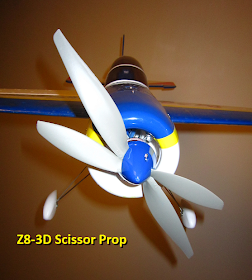Here are some initial, empirical test results:
Prop | Volts | Thrust | Amps | T/A |
11x4.7 SF | 12.6 | 40.6 | 35.4 | 1.15 |
11x5.5 APC | 12.6 | 38.8 | 28.7 | 1.35 |
11x5.5 APC + 8x3.8 SF | 12.6 | 44.3 | 31.2 | 1.42 |
The vortex aero theory behind the Z83DSP is the same used by an Eagle during low speed, high thrust maneuvering:
The Eagle splits his relatively low aspect ratio wing into a procession of high aspect ratio winglets, where each leading edge winglet's vortex rolls over the trailing winglet to energize top flow. There are two complex effects at play at once:
- The elliptical plan form of the Eagle's main wing and winglets reduce lift to zero at each fractal tip, maximally separating the bulk of lift from the finite wing tip, and thus, associated vortex losses. This is the same principal used in any elliptical wing aircraft design, perhaps the most famous of which is the Supermarine Spitfire.
- The procession of Eagle winglets, to include several mid-span wrist winglets, use their sub-tip vortices to energize airflow over the trailing winglet. This probably does not reduce the intensity of the overall wing tip vortex, it simply puts some portion of it to good use. This is the same principle copied in any vortex aero aircraft wing design, perhaps the most famous of which is the greatest fighter in aviation history, the F-16.
The Z83D Scissor Prop's smaller sub-wing vortex is rolled over the top of, and thus recycled into more lift for, the trailing primary prop blades. There is probably a more optimal alignment, diameter and pitch ratio than my prototype scissor.



